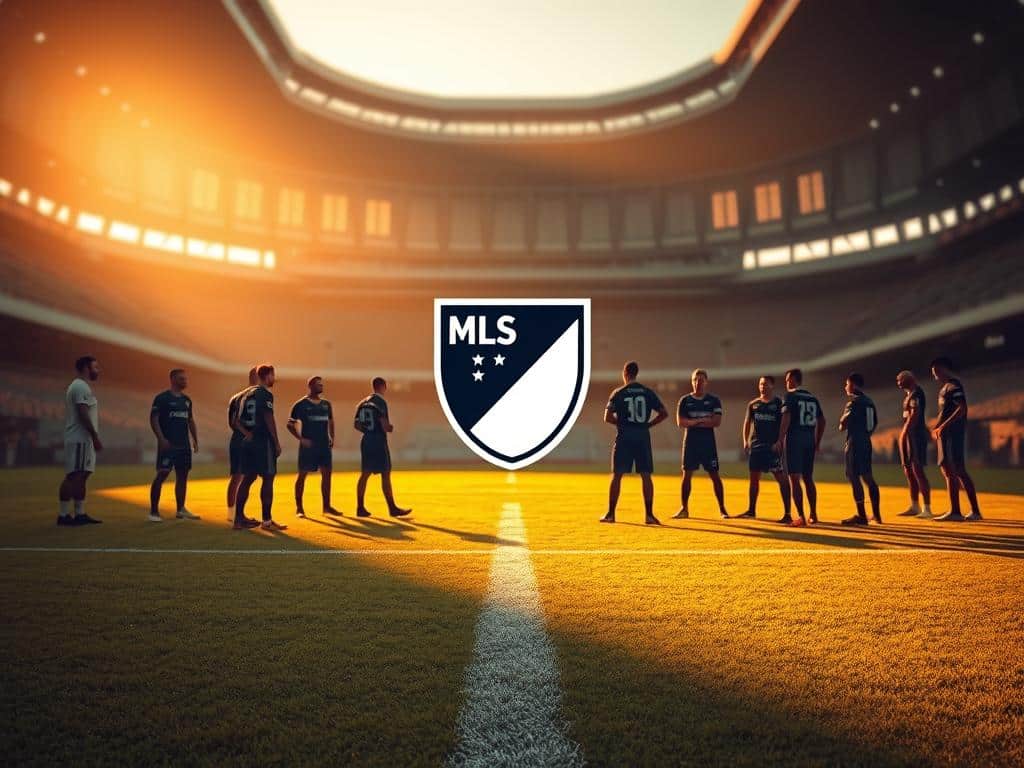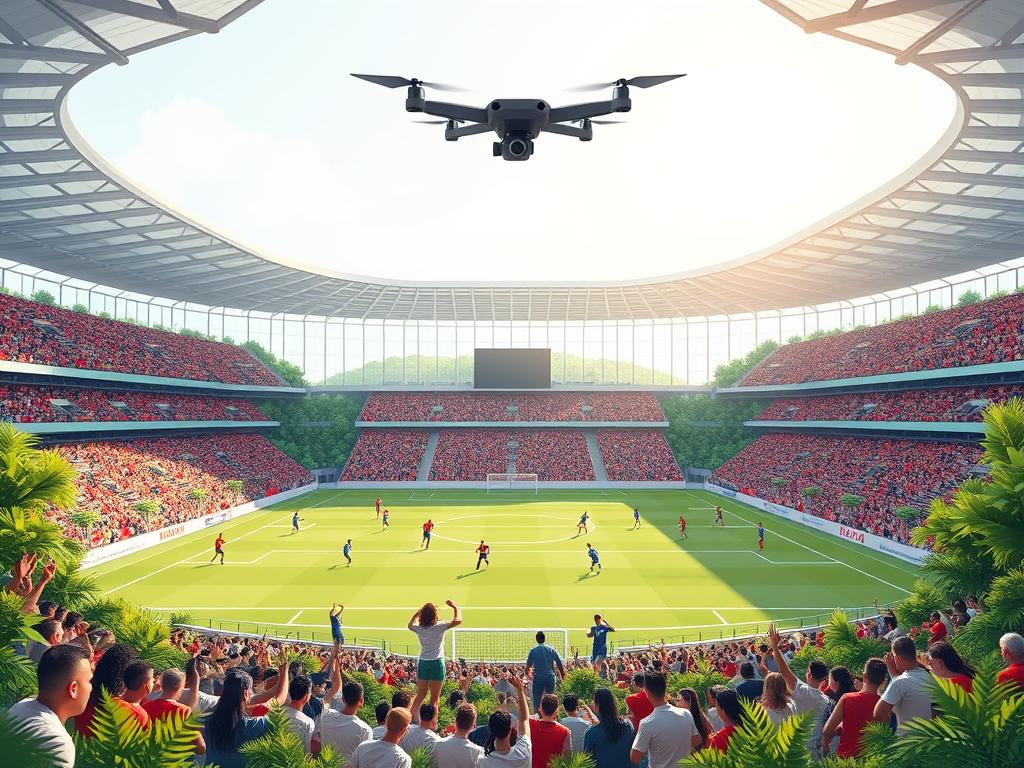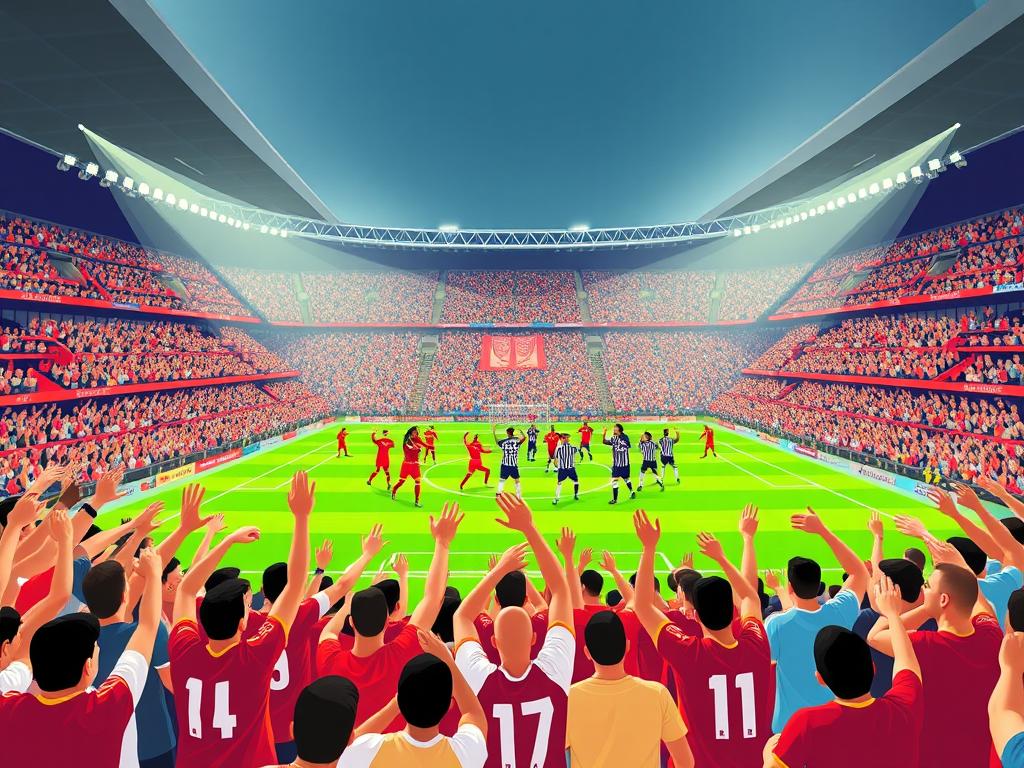Ever wondered how Major League Soccer teams bring global superstars to the league while staying competitive? The answer lies in the Designated Player Rule, a game-changing system that reshaped American soccer. Since 2007, this rule has allowed clubs to sign elite talent without breaking the salary cap.
Teams get three special roster spots to build championship-caliber squads. Whether it’s LA Galaxy signing David Beckham or Inter Miami recruiting Lionel Messi, this strategy fuels excitement and success. Ready to learn how it works? Let’s dive in!
What Is the Designated Player Rule in MLS?
Think of it as MLS’s golden ticket to signing game-changers. This system lets clubs bring in top-tier talent without wrecking their salary budgets. Since 2007, it’s helped teams like LAFC and Atlanta United build winning rosters.
Definition and Purpose
The rule acts like a superstar exception. Teams get three slots to sign players whose salaries exceed the cap. Instead of counting the full wage, only a portion hits the salary budget—$612,500 in 2023.
How It Differs from Standard Salary Cap Rules
Most leagues use hard caps, but MLS thrives on flexibility. Regular players count fully against the $5.2M cap. With this system, clubs can spend big on stars while staying competitive.
Young talents under 23 get even better deals—their cap hit drops to $150K. This helps teams develop future stars like Thiago Almada. Plus, allocation money (GAM/TAM) adds another layer of strategy.
Want to see how teams like Inter Miami use these tools? Keep reading!
The Birth of the “Beckham Rule”
A single contract reshaped American soccer in 2007. David Beckham’s $250M deal with LA Galaxy wasn’t just about goals—it was a masterclass in branding. The agreement even included a future franchise ownership option, blending sports and business like never before.
David Beckham’s Historic Signing
Beckham’s $6.5M yearly salary dwarfed MLS’s $2.1M team cap. Yet, his impact was instant. Galaxy sold over 300,000 jerseys in months—covering his wages before the season ended.
The transfer fee and hype weren’t just for show. Attendance spiked 25% league-wide, proving star power could lift the entire sport.
MLS’s Global Ambitions
Beckham’s arrival signaled MLS’s hunger to compete worldwide. Since then, 311 special signings have followed, from Thierry Henry to Lionel Messi.
The rule’s flexibility—like discounted slots for young talents—keeps evolving. With the 2026 World Cup coming, expect even bolder moves.
How the Designated Player Rule Works Today
2024 brings fresh twists to how clubs manage star signings. Teams now balance budget charges and strategic discounts to build winning rosters. Let’s break down the latest tactics.
Salary Budget Charges for DPs (2024 Figures)
Veteran stars over 23 now count $683,000 against the cap—up from 2023. But here’s the kicker: mid-season signings slash that budget charge by 50%. LAFC used this trick to add Denis Bouanga mid-2022, fueling their Cup run.
Clubs also use general allocation money (GAM) to “buy down” charges. This lets them squeeze extra value from each slot. Atlanta United, for example, combined GAM with a young designated player to free up space for Thiago Almada.
Young Designated Player Discounts
Under-23 talents like Almada hit the cap at just $150,000—a steal compared to veterans. Smart teams stack these discounts with pricier stars. The result? Balanced rosters with room for growth.
Why target young designated players? Their resale value often dwarfs aging stars. FC Dallas turned Ricardo Pepi’s $150K cap hit into a $20M transfer to Europe. That’s ROI even Wall Street would envy.
Pro tip: Teams can mix GAM and youth discounts to land three impact players. It’s like fitting three game-changers into two slots—pure roster magic.
MLS Salary Cap vs. Designated Player Spending
Balancing star power and financial limits is every MLS club’s ultimate challenge. While the 2024 salary budget sits at $5.47M, smart teams unlock over $10M in spending power with allocation money. Let’s break down how they pull it off.
2024 Base Salary Cap and Allocation Money
Teams start with a $5.47M cap but add $4.6M in extra funds. This combo lets clubs stretch budgets further. Nashville SC used this to build around Hany Mukhtar’s $5.2M deal while keeping roster depth.
Here’s the magic: Allocation money (GAM/TAM) can “buy down” a DP’s cap hit. For example, Toronto FC spread Lorenzo Insigne’s $15.4M contract across multiple years. Their secret? Strategic use of funds to soften the annual blow.
Calculating a DP’s Budget Impact
A veteran DP’s max charge is $683K against the cap—just 12% of the total pool. Philadelphia Union proves value isn’t always about price tags. Their mid-range DP Dániel Gazdag delivers 15+ goals yearly on a $1.8M salary.
Pro tip: Teams balance costs by mixing high-earners with young talents. Atlanta United’s Thiago Almada counts only $150K against the cap, freeing space for bigger names.
Want to build a winner? Master the salary budget game. Spend smart, not just big.
Types of Designated Players in MLS
Not all star signings are created equal in MLS—teams strategize differently based on talent and budget. Some chase household names, while others bet on future stars. Let’s break down the three MVP categories clubs use to dominate.

Star Veterans (e.g., Lionel Messi)
Think Lionel Messi’s $20.4M deal with Inter Miami. These icons draw crowds and deliver instantly. Their salaries soar past the cap, but their impact? Priceless.
LA Galaxy’s Zlatan Ibrahimović proved aging legends still dominate. But prime stars like Hany Mukhtar (Nashville SC) offer consistency. The choice? Flash vs. long-term results.
Young DPs Under Age 23
Atlanta United’s Thiago Almada shows why youth matters. At 22, his cap hit was just $150K—a steal for his playmaking.
Clubs like FC Dallas target these talents for resale value. Jesús Ferreira blossomed into a USMNT star, while NYCFC’s Talles Magno could fetch millions.
Mid-Career International Signings
Players like LAFC’s Denis Bouanga (28) or Austin FC’s Sebastián Driussi (27) hit their prime. They’re not cheap, but they’re proven performers.
Houston Dynamo’s Héctor Herrera anchors midfield with experience. These signings balance rosters—no rebuilds needed.
Pro tip: Seattle’s hybrid approach (Rusnák + Ruidíaz) mixes mid-career reliability with veteran flair. Versatility wins.
Teams’ Strategic Use of DP Slots
Winning teams don’t just sign stars—they build systems around them. Smart clubs treat their three slots like chess pieces, balancing immediate impact with long-term gains. Let’s explore two game-changing approaches.
Building Around a Marquee Player
LA Galaxy’s 2011-2014 dynasty shows how it’s done. Their Donovan-Keane-Beckham trio delivered two Cups while selling out stadiums. Beckham’s jersey sales alone covered his salary.
Pro tip: Pair legends with hungry scorers. Keane’s 104 goals came from Beckham’s assists. That’s how you maximize a marquee signing.
Investing in Future Transfers
Some clubs treat slots like stock options. Atlanta United bought Miguel Almirón for $8M and sold him for $26M. FC Dallas flipped Carlos Gruezo for 266% profit.
The secret? Target U-23 talents with high ceilings. LAFC turned Diego Rossi’s $4M fee into a $6M payday. These transfer fees fund future rosters.
Nashville’s Hany Mukhtar proves hybrids work. His $5M salary brings goals AND ticket sales. Whether you chase trophies or profits, strategy wins.
Notable Past Designated Players
Some athletes don’t just join the league—they redefine it. Over the years, legends like Thierry Henry and Zlatan Ibrahimović turned clubs into global attractions. Let’s revisit their magic moments.
Legends Who Built Legacies
Thierry Henry’s 2010-2014 NYRB stint was pure dominance. With 51 goals and 42 assists, he became the face of American soccer. His technical brilliance drew new fans to the sport.
Orlando City’s Kaká brought World Cup-winning pedigree. Though injuries limited him to 78 games, his 24 goals and leadership shaped the club’s identity. Compare that to Wayne Rooney’s player-coach role at D.C. United—both inspired in different ways.
Short-Term Storms
Zlatan’s 58-game LA Galaxy explosion (53 goals) was box-office gold. Attendance spiked 30%, proving star power sells. His bicycle kick against LAFC remains iconic.
NYCFC’s early years relied on trio Pirlo, Villa, and Lampard. Villa delivered, but Lampard’s injuries showed risks. Even Chelsea legends can struggle in MLS.
These players didn’t just play—they transformed how the world sees American soccer. Who’ll be next?
Current MLS Designated Players to Watch
From Messi’s magic to rising young talents, this year’s roster is packed with must-watch performers. Every club leverages its slots differently, blending star power with smart investments. Here’s who’s dominating the current mls season.
Breakdown by Club (2024 Season)
Inter Miami’s trio—Messi ($20.4M), Busquets ($8.7M), and Alba ($1.5M)—redefines teamwork. Their chemistry turns games into spectacles. Meanwhile, Atlanta United’s Thiago Almada proves youth can shine. His $150K cap hit is a steal for 10+ assists yearly.
St. Louis CITY SC’s João Klauss ($1.37M) delivers goals, while Toronto FC gambles on Lorenzo Insigne’s $15.4M deal. Philadelphia Union’s Dániel Gazdag ($1.8M) quietly chases the Golden Boot. Each club tells a unique story.
Emerging Young DPs
Under-23 talents are the league’s secret weapon. NYCFC’s Talles Magno dazzles with dribbling, and Charlotte FC’s Karol Świderski nets clutch goals. Vancouver’s Ryan Gauld orchestrates attacks like a veteran.
These athletes cost less against the cap but deliver big. FC Dallas’ past success with Ricardo Pepi ($20M transfer) shows why scouts flock to MLS.
- Track: Messi’s Inter Miami campaign for historic stats.
- Watch: Philly’s Gazdag—his 15-goal streak isn’t luck.
- Discover: Next-gen stars like Świderski and Magno.
- Analyze: Toronto’s high-stakes Insigne experiment.
Rules for Signing a Third Designated Player
Want to unlock a third star signing without penalties? Smart clubs use clever loopholes. While teams get three roster slots for elite talent, the third comes with a catch—unless you play by the age rules.
Luxury Tax and Allocation Money Exceptions
Sign a veteran over 23 as your third star? Prepare for a $150K luxury tax. Austin FC pays this for their Driussi-Rigoni-Ring trio. But LAFC dodged it by adding Denis Bouanga mid-season—his budget charge halved to $341,500.
Here’s the hack: allocation money (GAM) can “buy down” fees below $150K. Colorado saved cash by making 24-year-old Cabral their third DP. No tax, no fuss.
Advantages for Young DP Signings
Under-23 talents like Atlanta’s Thiago Almada skip the tax entirely. Their cap hit stays at $150K, freeing funds for bigger names. FC Dallas turned this into a $20M profit with Ricardo Pepi.
- LAFC’s move: Bouanga’s mid-season arrival avoided tax, fueling their 2022 Cup run.
- Galaxy’s gamble: Three veterans (Beckham/Keane/Donovan) paid the tax—but won titles.
- RSL’s strategy: One DP (Chicho Arango) lets them spend elsewhere.
Pro tip: Stack young slots with allocation money to create “phantom” DP space. That’s how contenders build deep rosters.
Secondary Transfer Window and DP Signings
Smart teams treat the mid-season window like a secret weapon. While winter signings grab headlines, summer moves often decide championships. The secondary transfer window (July–August) lets clubs patch weaknesses—with a bonus: prorated salary cap hits.

Mid-Season Budget Charge Reductions
Here’s the golden rule: Summer signings count 50% less against the cap. A veteran DP’s $683K charge drops to $341,500. LAFC exploited this in 2022, adding Denis Bouanga for half the cost. His 11 goals propelled them to MLS Cup.
Pro tip: Teams like Seattle target July signings to maximize value. A full season’s impact for half the cap hit? That’s roster magic.
Notable Summer Window DP Moves
2023’s transfer window rewrote the playbook. Inter Miami signed Messi and Busquets mid-season, prorating their salaries. Messi’s $20.4M deal? Only $10.2M hit the 2023 cap.
- LAFC’s masterstroke: Bouanga’s arrival for $341K fueled a title run.
- Atlanta’s gamble: Thiago Almada joined in July 2022—now worth triple his fee.
- Club opening secondary: NYCFC’s Talles Magno (U-23) cost just $75K against the cap.
Risks exist, though. Mid-season signings must adapt fast. But when they click—like Zlatan’s 2018 Galaxy debut—they’re unstoppable.
General Allocation Money (GAM) and DPs
General allocation money is the league’s best-kept roster hack. This budget tool lets clubs turn star salaries into cap-friendly deals. In 2024, each team gets $2.8M in GAM—enough to reshape their squad.
How Clubs “Buy Down” Salary Charges
Philadelphia Union turned Julián Carranza into a non-DP using GAM. By applying $1.5M (the max per player), they slashed his cap hit below the DP threshold. Result? A playoff-ready roster with flexibility.
Nashville SC keeps Hany Mukhtar as a DP despite his $5.2M salary. Their trick? Pairing his $683K cap charge with targeted general allocation money. This balances star power and depth.
Combining GAM with DP Flexibility
Stacking GAM and TAM creates “phantom” roster slots. For example:
- LAFC used funds to add Bouanga mid-season at half the cap cost.
- Atlanta United mixes Almada’s youth discount with GAM for extra signings.
- Avoid spreading funds too thin—focus on 2-3 impact players.
Pro tip: Track budget charges weekly. Teams like Seattle adjust GAM use based on injuries or form. Smart money moves win championships.
Designated Players and MLS Cup Success
Championships aren’t won by stars alone—they’re built through smart roster strategy. The best teams leverage elite talent while filling gaps with savvy role players. Let’s explore how Atlanta United and LAFC turned their DP slots into trophies.
Case Studies: Atlanta United 2018, LAFC 2022
Atlanta’s 2018 title run rewrote the playbook. Their South American DP trio—Miguel Almirón, Josef Martínez, and Ezequiel Barco—combined for 45 goals. Martínez’s record-breaking mls season (31 goals) proved how chemistry beats individual brilliance.
LAFC’s 2022 double (Supporters’ Shield + MLS Cup) showcased balance. Carlos Vela’s creativity paired with Denis Bouanga’s mid-season surge (11 goals). Their secret? Using allocation money to deepen the bench.
Balancing DPs with Roster Depth
Toronto FC’s 2017 “blood money” experiment failed despite big names. Their three DPs (Giovinco, Altidore, Bradley) lacked support. Contrast that with LAFC’s approach: two star DPs + rotational third (Bouanga).
Pro tip: Title-winning teams often follow this blueprint:
- Two impact DPs (scorer + playmaker)
- One flexible DP (young talent or mid-career star)
- Allocation money for depth (like LAFC’s Ilie Sánchez)
Over the years, the lesson is clear: Stars win games, but squads win championships.
Common Misconceptions About the DP Rule
Misunderstandings about star contracts can trip up even seasoned fans. While the rule lets clubs sign elite talent, it’s not a free pass—every deal impacts the salary cap. Let’s demystify two major myths.
Myth: “DPs Don’t Count Toward the Cap”
Here’s the kicker: Every player affects the budget, but at reduced rates. A veteran’s $2M salary might only count $683K against the cap. Young stars like Thiago Almada? Just $150K.
Even “free transfers” carry weight. Inter Miami’s Sergio Busquets costs $8.7M yearly, but his prorated cap hit is $341,500. Teams use general allocation money (GAM) to shrink charges further.
Clarifying Transfer Fee vs. Salary Rules
A $15M transfer fee (like Almada’s) spreads over the contract length. If he signs for 5 years, that’s $3M yearly added to his salary for cap calculations. But only the salary portion hits the budget.
Pro tip: TAM can’t cover fees—only salaries. That’s why Atlanta United used GAM to offset Almada’s $1M wage, keeping flexibility.
- Busted: No DP escapes the cap—just pays less.
- Watch: Fees amortize, but salaries dictate cap hits.
- Avoid: Assuming “free” signings like Busquets cost nothing.
The Future of the Designated Player Rule
By 2026, the game’s financial playbook could get a major rewrite. With the World Cup landing in North America, MLS is poised to leverage global attention. Teams are already adapting—58% of 2024’s elite signings are under 28, signaling a youth revolution.
Potential Changes Post-2026 World Cup
The league might expand DP slots or adjust cap charges. Imagine four roster spots for stars, or discounted slots for homegrown talents. Messi’s Inter Miami deal could inspire “legacy player” exceptions, rewarding icons who grow the sport.
Here’s the kicker: The 2027 CBA negotiations will shape these rules. Owners want flexibility, while players seek higher wages. The World Cup boom could fund both.
Growing Influence of Young DPs
Thiago Almada’s success proves youth isn’t just affordable—it’s profitable. The average DP age dropped to 26 this year, a trend that’ll accelerate. Clubs like FC Dallas bank on resale value, turning $1M signings into $20M transfers.
Pro tip: Watch MLS Next Pro. This development league feeds future stars, letting teams test young DPs before promoting them. Atlanta United’s recent moves hint at this pipeline.
- Track: CBA talks—they’ll redefine spending limits.
- Discover: How Messi’s contract influences legacy clauses.
- Analyze: Teams blending veterans (like Busquets) with U-23 talents.
Over the next few years, the league will balance marquee signings with smart development. The result? A deeper, more competitive MLS.
Mastering the DP Rule for MLS Fans
Ready to decode roster moves like a pro? Now that you’ve got the playbook—three slots, budget hacks, and allocation tricks—it’s time to spot the genius behind every signing.
Watch how clubs like LAFC maximize value while others fumble. Remember Inter Miami’s 2023 experiment? Not every big name guarantees success.
Predict the next blockbuster move. Will your team target a young star or a veteran? Use what you’ve learned to join the debate. Share your takes on social media and goal-oriented forums.
Pro tip: Track mid-season signings—they often deliver championship magic. Now go analyze like a true fan!







